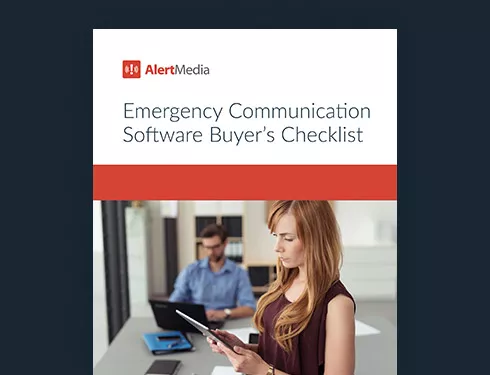
Emergency Notification System Vendors Evaluation Guide

If you’re here, it’s likely because your organization has identified a gap in your internal communication strategy. Perhaps there was a recent incident where you needed to urgently communicate information to a large group of people and didn’t have an efficient means to do so. Or maybe you have a host of communication tools but find yourself spending too much time transmitting the same or similar information across each to ensure the right audience receives the right message.
Regardless of your situation, if you don’t already have a dedicated emergency notification system in place, chances are that there is a better, more efficient way your organization could be communicating during emergencies and other critical events. Below, we’ll cover everything you need to know about emergency communication systems, their benefits, and how to select the right vendor for your organization.
What Is an Emergency Notification System?
Put simply, an emergency notification system (also referred to as “mass notification software” or “emergency communication solution” or “mass notification solution”) is an internal communication tool that provides a simple, central messaging interface used to send notifications to any size audience, on any device, over any communication channel, all over the world.
During an emergency that threatens public safety and business continuity, the most important step an organization can include in their emergency management plan is to inform and alert the people in harm’s way as quickly as possible. How they accomplish this varies widely, but thanks to emerging technology and cultural shifts, emergency notification systems have become increasingly more effective in protecting people and ensuring business continuity.
Whether it’s a Fortune 100 business, a branch or agency of the government, an SMB, a nonprofit, university, or any other organization, emergency alerting requires the right mix of people, process, and technology to ensure a timely and effective response. Modern emergency notification systems are designed to reach large audiences across the most communication channels to ensure those that need to receive the information see it quickly. As communication preferences change and new technologies emerge, emergency notification system providers typically expand supported communication channels to make it as easy as possible for customers to reach employees however they choose to receive information.
Basic emergency notification system features
Now that you understand what an emergency notification system is, let’s explore a few of the baseline features that every system should have.
Multichannel notifications – Today’s communication channels differ from those even a decade ago. Many employees respond more reliably and faster via mobile devices using communication channels like text messages and push notifications. Sending notifications over multiple channels, including SMS messaging, email, phone calls, social media, desktop alerts, and mobile app helps ensure that your messages reach the right people at the right time.
Two-way communication – During a critical event, it’s often important to communicate back and forth with your employees. Whether you need to verify their safety or elicit feedback, two-way emergency alerts gives your organization the benefit of audience participation.
Geofencing – Sometimes, you need to reach a group of people in one specific location outside your facilities. Geofencing enables an administrator to draw a virtual fence around a particular area of concern on a map and send messages to all employees within that fenced area. This is particularly helpful during natural disasters, bomb threats, hazardous material spills, riots or protests, or less nefarious situations, such as power outages, IT disruptions, or major traffic delays.
Audience grouping – If your company has a dispersed workforce, multiple locations, traveling employees, or remote workers, you will need an emergency notification product that will allow you to segment your target population. Audience grouping ensures the right audience receives the message and eliminates unnecessary messages from being transmitted across the system. The more irrelevant messages people receive, the more they tend to ignore them, and the system becomes less powerful.
Notification templates – Creating a message during an emergency can be stressful and waste precious seconds. A modern alert system will enable you to create pre-built messages for the most likely scenarios and use templates to guide you through message creation.
Enterprise-grade security – To reduce or eliminate your risk, an emergency alert system should provide proper protocols to protect your information. All of your information should be encrypted both in transit and at rest. The vendor should also maintain industry-standard application security, measurement, and monitoring protocols to protect your business.
Emergency Mass Notification System Tiers
As with many software categories, there are multiple tiers of vendors marketing emergency notification systems; however, a discerning buyer will find that functionality varies drastically from one vendor to another. For that reason, it’s important to familiarize yourself with the various options available regardless of whether your organization already has a system in place or is just getting started. When examining the emergency notification system landscape, there are three distinct tiers of solutions you will encounter:
Tier #1: Modern, enterprise-grade solutions
These are emergency-grade systems built to support the broadest range of organizations, industries, and use cases. They have all of the features outlined in the above section, invest heavily in infrastructure to ensure 24/7 availability, offer exceptional technical support, have an intuitive user interface, provide enterprise-grade security, and are constantly developing new features to help organizations keep their people and business safe.
Put simply, these are the only systems built to keep people safe during emergency situations.
Tier #2: Legacy systems & add-ons
Tier two systems are often marketed as emergency notification systems but lack several key features like multichannel notification delivery, two-way messaging, and geofencing that safety-conscious organizations need to protect their people and business during emergencies. At one point, these systems might have been considered tier one, but they stopped investing in their product and allowed other systems to surpass them. Conversely, these systems might have entered the market as a tier-three system and “upgraded” their features to be somewhat serviceable (but certainly not ideal) during an emergency.
Tier #3: Mass messaging services
These are your basic, one-way text messaging or email systems. These systems allow your organization to broadcast (or “blast”) messages to a large audience but don’t allow for the recipients to respond and provide no way for your organization to see who received the message—assuming they received the message at all. These systems are also notorious for being unreliable when it comes to message deliverability.
While these systems might be ideal for marketing a product or service to a list of subscribers, tier three systems simply aren’t suitable for critical event management.
Mapping Your Organizational Needs
Whether you’re accountable for facilities at a large healthcare provider, overseeing safety in higher education, or concerned about maintaining continual operations at a small business, every organization has unique challenges, needs, and priorities. Those factors will, in part, determine the requirements you’ll demand from your emergency notification system vendor.
Here’s what you’ll want to know about your organization before addressing the possible requirements:
People – Think about how many people you will have in the system and how many people you will want to empower with administrative abilities. Your audience size will influence roll-out programs, system infrastructure and scaling needs, and other permissions and customization options to extend the technology to the right people in the most appropriate way.
Locations – Map your organization with an understanding of your international and domestic footprints, satellite offices, and traveling or remote employees. It’s helpful to think through the needs and communication preferences for every location and audience.
Groups – Identify all of the audiences you’ll want to reach with your different notifications. It’s common to have audiences defined by location, department, job function, management level, and projects. You can also have custom filters that segment audiences based on communication needs specific to your business.
Culture – Consider the cultural norms of your people, your company, and the communities they serve.
Needs checklist – Emergency notification software is used to send notifications around any critical event. Those events could be related specifically to your business, could be local threats, or even important developments that you’ll want to share with customers, partners, or employees. Think about how the different use cases (Emergency Mass Notifications, Operations Notifications, and Business Communications) apply to your organization and which elements you’ll want to use with an emergency notification system.
Establishing Your Requirements
Now that you have a solid grasp of the foundational elements behind your organization, it’s important to think through the various features you will want to consider as you begin your evaluation. While various emergency notification system vendors offer many features and customizations, you will benefit from having an opinion on the most important features. Knowing to ask for these features and why they are important will facilitate your evaluation and empower you to assess alerting system vendors quickly.

Emergency notification system vendors can offer a wide range of notification services and features. Establish your criteria and communication plan by understanding the options available to you and your people.
Mobile – We live in a world where most people have smartphones. As such, we’re able to establish a powerful communication channel on the most commonly used devices around the globe. According to Statista, there are over 6 billion smartphone users, and the number is growing by several hundred million every year. So whether your organization provides smartphones or not, your people more than likely have smartphones in their pocket, and they will happily use them to improve their safety and connectedness during emergency events.
Global threat intelligence — Speaking of “mobile,” your workforce is more mobile than ever. Whether you have full-time remote employees, business travelers, or a dispersed workforce, you have a duty of care to protect your people. An emergency notification system with global threat intelligence capabilities allows you to see critical events unfolding near your people or assets. You can view all emerging and current threats on an interactive map—where you can also see your organization’s office locations, traveling employees, employee home addresses (which are especially important during remote work), and other business-critical assets. When a threat emerges that could impact your company, system admins are immediately notified so that they can contact the affected parties and first responders. You can even automate the emergency notification process and have your at-risk employees alerted when a threat emerges so that not a second is lost.
Multichannel messaging – Emergency notification system vendors help you deliver messages that are more important than email. When your people must receive the notification, you’ll need to send your notification over multiple communication channels simultaneously. What channels make sense for your audience(s)? At a minimum, demand that your vendor offers simple ways to communicate across text/SMS, voice call, mobile applications, email, desktop alerts, and social channels—all with a few clicks.
Localization – If you have a global audience, you’ll need the ability to send emergency alerts in any language. Your emergency notification system vendor needs to be UTF-compliant and allow for messages to be written in any language.
Fast – Response times are a crucial component of effective emergency management, so the speed of your emergency notification system should not be overlooked. Whether you’re sending to an audience of 100 or 10,000, critical emergency notifications need to reach your people in seconds, not minutes or hours.
Ease of use – During a critical event, you don’t have time to learn or re-learn a software tool. And you don’t have time to train all of your administrators, particularly those who may only use the system once a quarter, or even once a year. An intuitive design will walk you through creating and sending emergency notifications without the training!
Administrative burden – Selecting from your options of emergency notification system vendors isn’t just a process of understanding technology. It’s also about understanding the administrative burden required to implement and maintain your system. Focus on training requirements, any heavy-lifting around setup, the vendor’s support structure, and smart integrations that reduce the need for constant management.
Reporting and analytics – You need to understand how your organization reacts around an event, so you’ll want to require real-time reporting that outlines delivery metrics, group structures and hierarchies, and user-specific insights.
Location services and mapping – When you’re tracking events around and related to your business, you’ll need to share those events with your people in the local areas. Building audiences based on location – both current location as signaled by the mobile app and assigned location as an attribute – will give you the power to find the right audience at the right time and in the right location.
Geofencing – Just looking at a map isn’t enough. You need to see people on the map and “grab” those people to create a dynamic audience for communication around real-time events.
Customer success – Don’t just look into features and processes; look into an emergency notification system vendor’s approach to your success. You don’t want to simply procure a piece of software, you want an extension of your team to help you deploy, maintain, and use the system.
24/7 support – Events happen around the clock, and you need a vendor ready to support you and the team 24 hours a day.
API access – Modern software vendors offer APIs to provide you access to their technology for customized uses and integrations. A well-thought-out and documented API will provide libraries of common actions in the code used by your developers.
Pre-built communication templates – You need every advantage when every second counts. You’ll need to require that your software vendor has intuitive, easily managed emergency notification templates built for those predictable notifications.
Audience feedback features – Don’t settle on just sending a one-way notification. Broadcasting an emergency message is just part of the story. Instead, give your audience a voice, let them call for help, and share insights from the front line. Your criteria should include feedback mechanisms like read receipts, surveys, and replies.
Enterprise-grade security – Your organization’s emergency notification system vendor needs to offer a secure infrastructure that provides full SSL, encryption at-rest and in-transit, identity and access management, and other monitoring and auditing techniques that safeguard your data.
Emergency Notification System Pricing
The pricing of emergency notification systems varies widely and is largely dependent on three main factors:
Number of users – Most emergency notification system vendors will charge a flat subscription fee based on the number of users the customer plans to have in the system.
Messages sent – While a total number of users will provide the vendor with a baseline number of messages sent and received, circumstances often arise that would cause an organization to exceed that number. If the customer exceeds the initial message allocation, the emergency notification system vendors should simply charge them for those additional messages. That said, some vendors will charge an additional overage fee, so make sure you understand how your pricing is structured before agreeing to a contract.
Features – This is where many vendors take the opportunity to squeeze as much profit out of their customers as possible. Many vendors will nickel and dime their customers with additional costs for customer service, training, and basic features like geofencing capabilities. It’s important to closely examine any pricing you receive from an emergency notification system vendor to ensure that there are no hidden terms or fees and that you are not paying for features you do not need.
The value of an emergency notification system
While an organization can spend anywhere from $500 to $1,000,000 a month on an emergency notification system, the value of that system will always outweigh the cost. That’s because an emergency notification system helps organizations protect their people and assets during critical events, improve operational efficiencies, and reduce downtime. And while you cannot put a price on the lives of your employees, there are third-party studies that show that an emergency notification system can generate an incredibly high ROI.
Other Resources About Emergency Communication Systems
Emergency Notification System Overview – Learn how to keep your people safe, informed, and connected.
AlertMedia Key Product Features – You can download a document outlining AlertMedia’s highlighted features to help build your criteria or match your requirements against our system.
What Makes the Best Emergency Notification System Vendor?
With customers across 130+ countries, AlertMedia knows what makes for a great emergency notification system vendor. We deliver world-class customer support to go with our easy-to-use, innovative emergency notification software that works across all of your devices.
Technology
Our world-class software sends quick, reliable, and secure notifications. We’ll ensure your critical messages always reach the right audience at the right time.
Support
Our customers benefit from our deep expertise and hands-on approach. Day or night, our team is on standby to help you navigate whatever situation you encounter, acting as an extension of your team.
Innovation
Our product and engineering teams are redefining mass communications. We are constantly innovating on your behalf and adding capabilities to meet the evolving needs your organization.

